adding oil Mercury Mountaineer 2003 Owner's Manuals
[x] Cancel search | Manufacturer: MERCURY, Model Year: 2003, Model line: Mountaineer, Model: Mercury Mountaineer 2003Pages: 264, PDF Size: 2.5 MB
Page 76 of 264
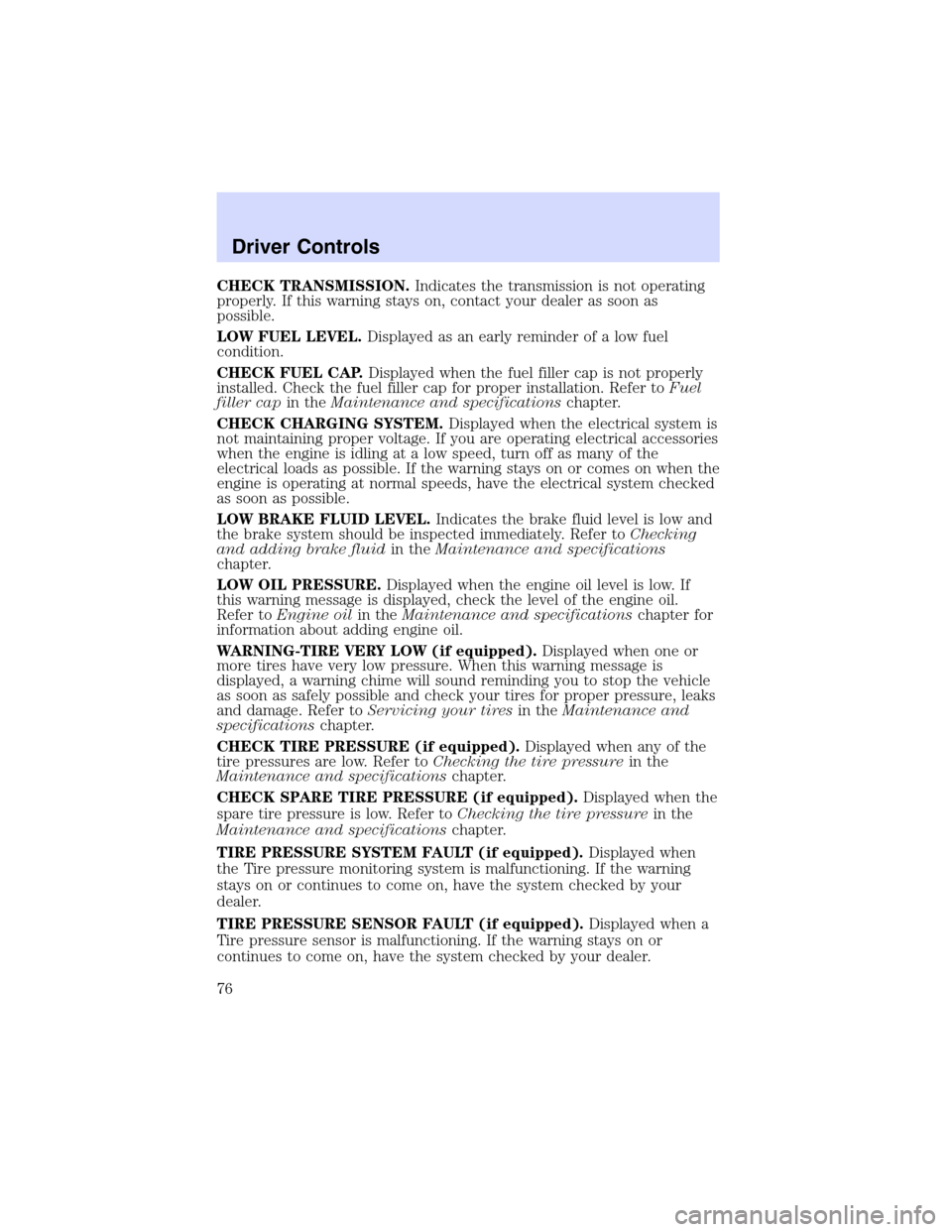
CHECK TRANSMISSION.Indicates the transmission is not operating
properly. If this warning stays on, contact your dealer as soon as
possible.
LOW FUEL LEVEL.Displayed as an early reminder of a low fuel
condition.
CHECK FUEL CAP.Displayed when the fuel filler cap is not properly
installed. Check the fuel filler cap for proper installation. Refer toFuel
filler capin theMaintenance and specificationschapter.
CHECK CHARGING SYSTEM.Displayed when the electrical system is
not maintaining proper voltage. If you are operating electrical accessories
when the engine is idling at a low speed, turn off as many of the
electrical loads as possible. If the warning stays on or comes on when the
engine is operating at normal speeds, have the electrical system checked
as soon as possible.
LOW BRAKE FLUID LEVEL.Indicates the brake fluid level is low and
the brake system should be inspected immediately. Refer toChecking
and adding brake fluidin theMaintenance and specifications
chapter.
LOW OIL PRESSURE.Displayed when the engine oil level is low. If
this warning message is displayed, check the level of the engine oil.
Refer toEngine oilin theMaintenance and specificationschapter for
information about adding engine oil.
WARNING-TIRE VERY LOW (if equipped).Displayed when one or
more tires have very low pressure. When this warning message is
displayed, a warning chime will sound reminding you to stop the vehicle
as soon as safely possible and check your tires for proper pressure, leaks
and damage. Refer toServicing your tiresin theMaintenance and
specificationschapter.
CHECK TIRE PRESSURE (if equipped).Displayed when any of the
tire pressures are low. Refer toChecking the tire pressurein the
Maintenance and specificationschapter.
CHECK SPARE TIRE PRESSURE (if equipped).Displayed when the
spare tire pressure is low. Refer toChecking the tire pressurein the
Maintenance and specificationschapter.
TIRE PRESSURE SYSTEM FAULT (if equipped).Displayed when
the Tire pressure monitoring system is malfunctioning. If the warning
stays on or continues to come on, have the system checked by your
dealer.
TIRE PRESSURE SENSOR FAULT (if equipped).Displayed when a
Tire pressure sensor is malfunctioning. If the warning stays on or
continues to come on, have the system checked by your dealer.
Driver Controls
76
Page 215 of 264
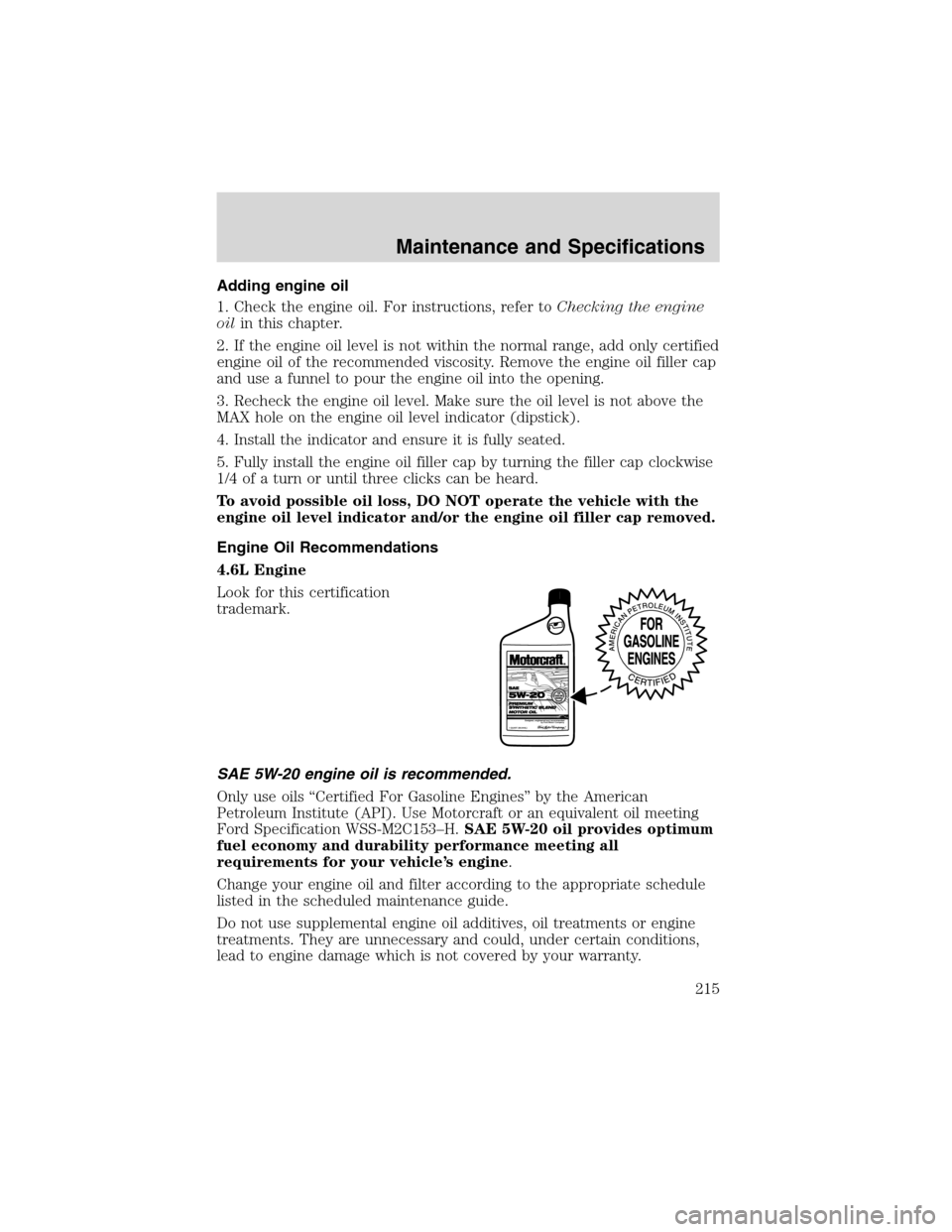
Adding engine oil
1. Check the engine oil. For instructions, refer toChecking the engine
oilin this chapter.
2. If the engine oil level is not within the normal range, add only certified
engine oil of the recommended viscosity. Remove the engine oil filler cap
and use a funnel to pour the engine oil into the opening.
3. Recheck the engine oil level. Make sure the oil level is not above the
MAX hole on the engine oil level indicator (dipstick).
4. Install the indicator and ensure it is fully seated.
5. Fully install the engine oil filler cap by turning the filler cap clockwise
1/4 of a turn or until three clicks can be heard.
To avoid possible oil loss, DO NOT operate the vehicle with the
engine oil level indicator and/or the engine oil filler cap removed.
Engine Oil Recommendations
4.6L Engine
Look for this certification
trademark.
SAE 5W-20 engine oil is recommended.
Only use oils“Certified For Gasoline Engines”by the American
Petroleum Institute (API). Use Motorcraft or an equivalent oil meeting
Ford Specification WSS-M2C153–H.SAE 5W-20 oil provides optimum
fuel economy and durability performance meeting all
requirements for your vehicle’s engine.
Change your engine oil and filter according to the appropriate schedule
listed in the scheduled maintenance guide.
Do not use supplemental engine oil additives, oil treatments or engine
treatments. They are unnecessary and could, under certain conditions,
lead to engine damage which is not covered by your warranty.
Maintenance and Specifications
215
Page 219 of 264
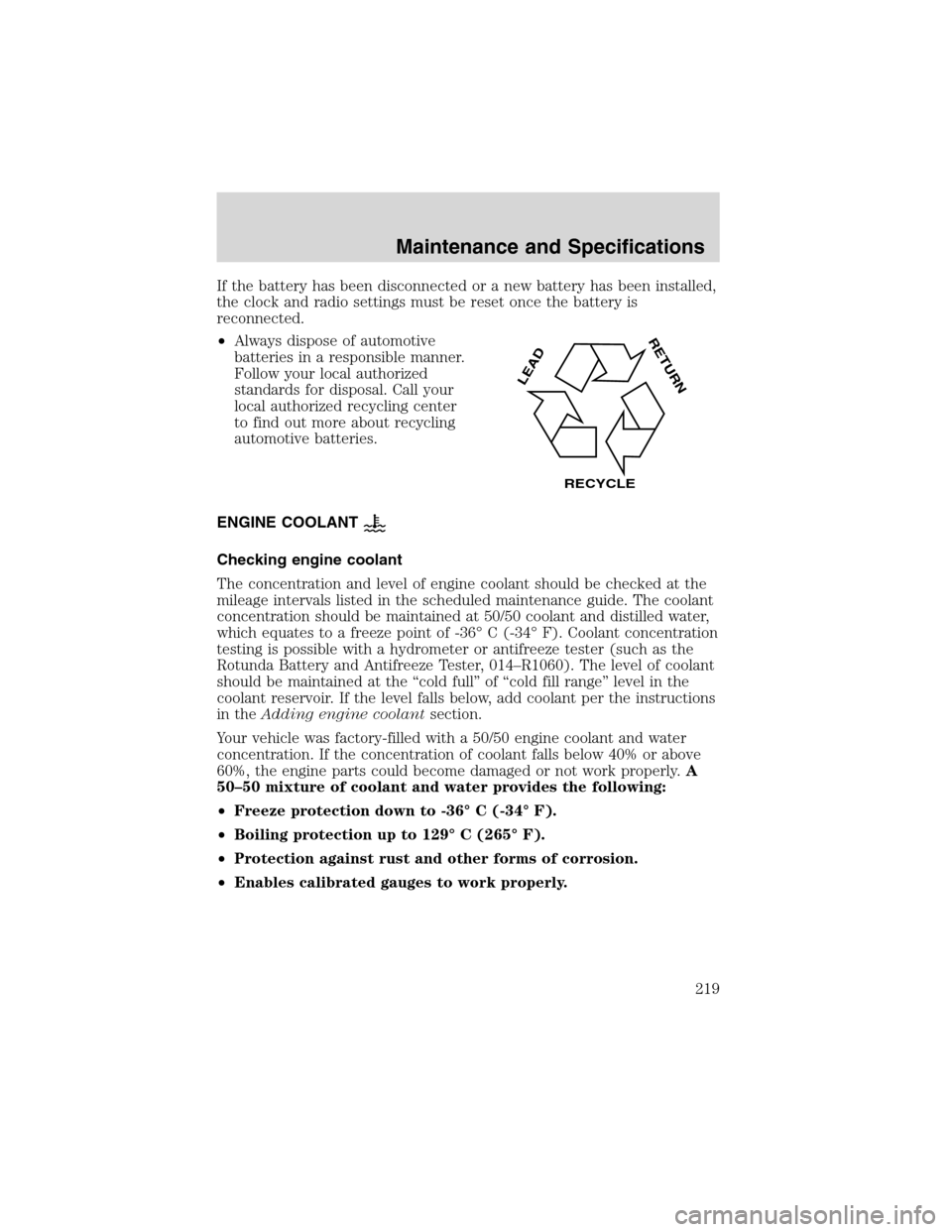
If the battery has been disconnected or a new battery has been installed,
the clock and radio settings must be reset once the battery is
reconnected.
•Always dispose of automotive
batteries in a responsible manner.
Follow your local authorized
standards for disposal. Call your
local authorized recycling center
to find out more about recycling
automotive batteries.
ENGINE COOLANT
Checking engine coolant
The concentration and level of engine coolant should be checked at the
mileage intervals listed in the scheduled maintenance guide. The coolant
concentration should be maintained at 50/50 coolant and distilled water,
which equates to a freeze point of -36°C (-34°F). Coolant concentration
testing is possible with a hydrometer or antifreeze tester (such as the
Rotunda Battery and Antifreeze Tester, 014–R1060). The level of coolant
should be maintained at the“cold full”of“cold fill range”level in the
coolant reservoir. If the level falls below, add coolant per the instructions
in theAdding engine coolantsection.
Your vehicle was factory-filled with a 50/50 engine coolant and water
concentration. If the concentration of coolant falls below 40% or above
60%, the engine parts could become damaged or not work properly.A
50–50 mixture of coolant and water provides the following:
•Freeze protection down to -36°C (-34°F).
•Boiling protection up to 129°C (265°F).
•Protection against rust and other forms of corrosion.
•Enables calibrated gauges to work properly.
LEAD
RETURN
RECYCLE
Maintenance and Specifications
219
Page 233 of 264
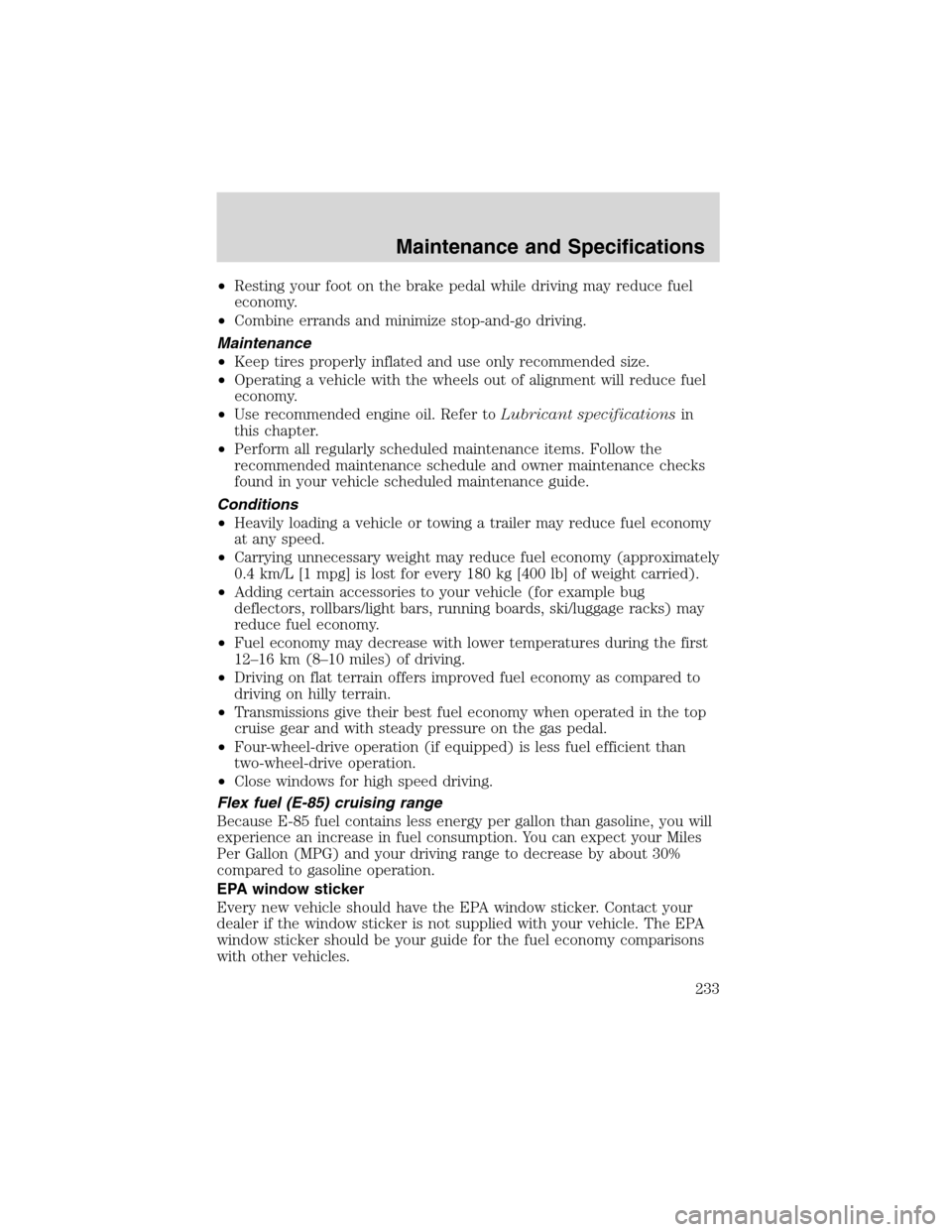
•Resting your foot on the brake pedal while driving may reduce fuel
economy.
•Combine errands and minimize stop-and-go driving.
Maintenance
•Keep tires properly inflated and use only recommended size.
•Operating a vehicle with the wheels out of alignment will reduce fuel
economy.
•Use recommended engine oil. Refer toLubricant specificationsin
this chapter.
•Perform all regularly scheduled maintenance items. Follow the
recommended maintenance schedule and owner maintenance checks
found in your vehicle scheduled maintenance guide.
Conditions
•Heavily loading a vehicle or towing a trailer may reduce fuel economy
at any speed.
•Carrying unnecessary weight may reduce fuel economy (approximately
0.4 km/L [1 mpg] is lost for every 180 kg [400 lb] of weight carried).
•Adding certain accessories to your vehicle (for example bug
deflectors, rollbars/light bars, running boards, ski/luggage racks) may
reduce fuel economy.
•Fuel economy may decrease with lower temperatures during the first
12–16 km (8–10 miles) of driving.
•Driving on flat terrain offers improved fuel economy as compared to
driving on hilly terrain.
•Transmissions give their best fuel economy when operated in the top
cruise gear and with steady pressure on the gas pedal.
•Four-wheel-drive operation (if equipped) is less fuel efficient than
two-wheel-drive operation.
•Close windows for high speed driving.
Flex fuel (E-85) cruising range
Because E-85 fuel contains less energy per gallon than gasoline, you will
experience an increase in fuel consumption. You can expect your Miles
Per Gallon (MPG) and your driving range to decrease by about 30%
compared to gasoline operation.
EPA window sticker
Every new vehicle should have the EPA window sticker. Contact your
dealer if the window sticker is not supplied with your vehicle. The EPA
window sticker should be your guide for the fuel economy comparisons
with other vehicles.
Maintenance and Specifications
233
Page 257 of 264
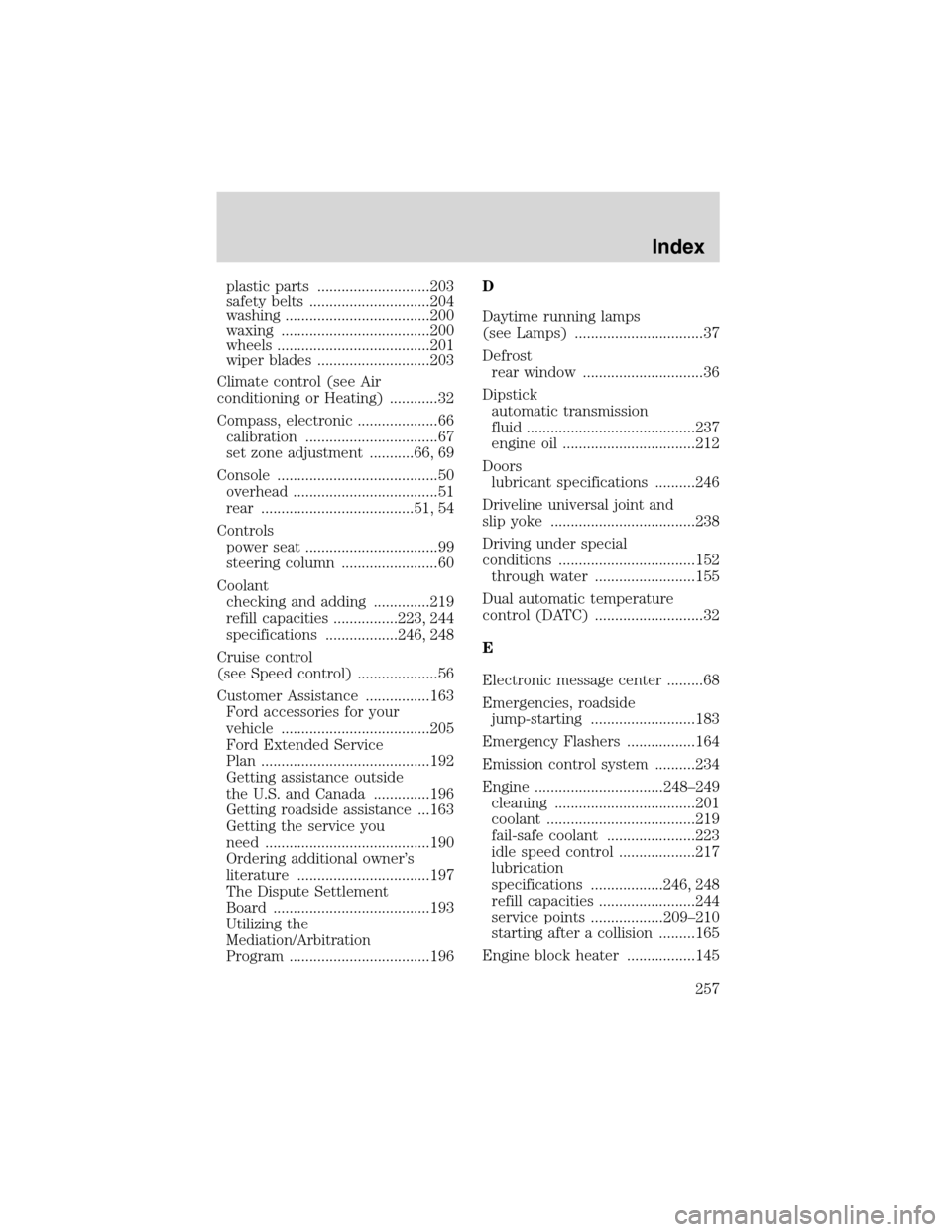
plastic parts ............................203
safety belts ..............................204
washing ....................................200
waxing .....................................200
wheels ......................................201
wiper blades ............................203
Climate control (see Air
conditioning or Heating) ............32
Compass, electronic ....................66
calibration .................................67
set zone adjustment ...........66, 69
Console ........................................50
overhead ....................................51
rear ......................................51, 54
Controls
power seat .................................99
steering column ........................60
Coolant
checking and adding ..............219
refill capacities ................223, 244
specifications ..................246, 248
Cruise control
(see Speed control) ....................56
Customer Assistance ................163
Ford accessories for your
vehicle .....................................205
Ford Extended Service
Plan ..........................................192
Getting assistance outside
the U.S. and Canada ..............196
Getting roadside assistance ...163
Getting the service you
need .........................................190
Ordering additional owner’s
literature .................................197
The Dispute Settlement
Board .......................................193
Utilizing the
Mediation/Arbitration
Program ...................................196D
Daytime running lamps
(see Lamps) ................................37
Defrost
rear window ..............................36
Dipstick
automatic transmission
fluid ..........................................237
engine oil .................................212
Doors
lubricant specifications ..........246
Driveline universal joint and
slip yoke ....................................238
Driving under special
conditions ..................................152
through water .........................155
Dual automatic temperature
control (DATC) ...........................32
E
Electronic message center .........68
Emergencies, roadside
jump-starting ..........................183
Emergency Flashers .................164
Emission control system ..........234
Engine ................................248–249
cleaning ...................................201
coolant .....................................219
fail-safe coolant ......................223
idle speed control ...................217
lubrication
specifications ..................246, 248
refill capacities ........................244
service points ..................209–210
starting after a collision .........165
Engine block heater .................145
Index
257
Page 258 of 264

Engine oil ..................................212
checking and adding ..............212
dipstick ....................................212
filter, specifications ........215, 243
recommendations ...................215
refill capacities ........................244
specifications ..................246, 248
Exhaust fumes ..........................145
F
Fail safe cooling ........................223
Flexible Fuel Vehicle (FFV) ....225
Floor mats ...................................79
Fluid capacities .........................244
Foglamps .....................................37
Four-Wheel Drive vehicles
preparing to drive your
vehicle .....................................148
Fuel ............................................225
calculating fuel
economy ............................70, 230
cap ...........................................229
capacity ...................................244
choosing the right fuel ...........227
comparisons with EPA fuel
economy estimates .................233
detergent in fuel .....................229
filling your vehicle with
fuel ...........................225, 229, 231
filter, specifications ........230, 243
fuel pump shut-off switch .....165
improving fuel economy ........230
octane rating ...........228, 248–249
quality ......................................228
running out of fuel .................229
safety information relating to
automotive fuels .....................225
Fuel - flex fuel vehicle
(FFV) .........................225, 227–228Fuses ..................................166–167
G
Garage door opener ..............52, 62
Gas cap (see Fuel cap) ............229
Gas mileage
(see Fuel economy) .................230
Gauges .........................................14
GAWR (Gross Axle Weight
Rating) .......................................156
calculating ...............................157
definition .................................156
driving with a heavy load ......156
location ....................................156
GVWR (Gross Vehicle Weight
Rating) .......................................156
calculating .......................156–157
definition .................................156
driving with a heavy load ......156
location ....................................156
H
Hazard flashers .........................164
Head restraints ...........................97
Headlamps
aiming ........................................39
bulb specifications ....................41
daytime running lights .............37
flash to pass ..............................38
high beam .................................38
Heating
heating and air conditioning
system .................................31–32
HomeLink universal
transceiver (see Garage door
opener) ..................................62, 65
Hood ..........................................207
Index
258